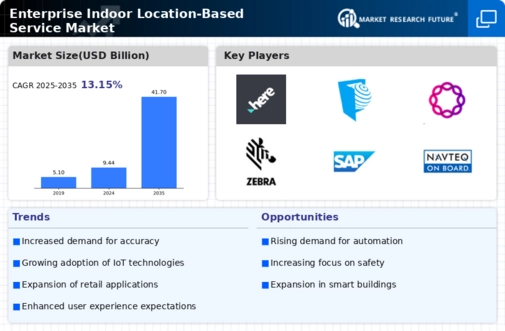The Enterprise Indoor Location Based Service Market has been witnessing significant growth driven by advancements in technology and increasing demand for more accurate location data in complex indoor environments. This market comprises various players that are leveraging innovative solutions to enhance spatial awareness and improve user experiences in retail, logistics, healthcare, and other sectors. The competitive landscape is characterized by a mixture of established companies and emerging startups, all striving to develop state-of-the-art technologies such as Wi-Fi positioning, Bluetooth low-energy beacons, and sensor fusion to cater to the unique needs of enterprises.
As industries recognize the value of indoor navigation and location services, competition becomes increasingly focused on differentiation through the enhancement of service offerings, overall reliability, and integration capabilities with existing operational frameworks.
HERE Technologies has established itself as a formidable player in the Enterprise Indoor Location Based Service Market, focusing on providing comprehensive mapping and location services tailored for indoor navigation. The company benefits from robust geographic data aggregation capabilities and established partnerships that enhance its market presence. HERE Technologies boasts a strong technological backbone that enables it to offer precision indoor mapping and real-time location tracking, which are critical for various applications, including asset tracking, workflow optimization, and enhanced customer experiences.
The strength of HERE Technologies lies in its commitment to continuously innovating its services and enhancing user engagement through advanced features like interactive maps and analytics. This innate ability to blend high-quality data with user-friendly interfaces positions HERE Technologies favorably against competitors, making it a leading service provider in this evolving market.IndoorAtlas has emerged as an innovative solution provider within the Enterprise Indoor Location
Based Service Market, recognized for its unique approach to indoor positioning using magnetic field data. The company’s strength is anchored in its proprietary technology, which allows for high-accuracy location services without relying on traditional infrastructure such as GPS, making it an attractive option for industries that face challenges with conventional positioning methods. IndoorAtlas focuses on providing businesses with seamless integration of indoor positioning capabilities into their existing systems, driving real-time analytics and enhancing operational efficiency. This seamless adaptability allows businesses in sectors like retail, healthcare, and facility management to accurately track assets, streamline workflows, and improve customer experiences.
IndoorAtlas's commitment to continually refining its technology and user experience is one of the key differentiators that strengthen its competitive position in the market landscape.
























Leave a Comment